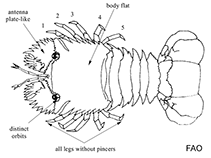Scyllarides deceptor Holthuis, 1963
Hooded slipper lobster| Native range | All suitable habitat | Point map | Year 2050 |

|
| This map was computer-generated and has not yet been reviewed. |
| Scyllarides deceptor AquaMaps Data sources: GBIF OBIS |
Hochladen Photos
Google Bild | No image available for this species;
drawing shows typical species in Scyllaridae.
Google Bild | No image available for this species;
drawing shows typical species in Scyllaridae.
Classification / Names Common names | Synonyms | CoL | ITIS | WoRMS
| Decapoda | Scyllaridae
Environment: milieu / climate zone / depth range / distribution range Ökologie
; tiefenbereich 45 - 200 m (Ref. 4). Tropical; 7°S - 43°S, 63°W - 33°W (Ref. 4)
Verbreitung Länder | FAO Gebiete | Ecosystems | Vorkommen | Einführungen
Western Atlantic: Brazil and Argentina.
Length at first maturity / Size / Gewicht / Alter
Maturity: Lm ?, range 9 - ? cm Max length : 32.6 cm TL Männchen/unbestimmt; (Ref. 106366); 36 cm TL (female)
It has carapce lengths of 5 to 12 cm (Ref.4). Found in depths between 45 and 200 m. Little is known about the substrate on which the animals live, except for one record from a sandy bottom (Ref. 4). In general, Scyllarides sp. inhabits the intertidal zone; many prefer rocky substrates while others are on muddy or sandy bottoms (Ref. 106789). Scyllarids are mainly carnivorous scavengers preferring small benthic invertebrates (Ref. 106995).
Life cycle and mating behavior Geschlechtsreife | Fortpflanzung | Ablaichen | Eier | Fecundity | Larven
Mating behavior: Precopulatory courtship ritual is common (through olfactory and tactile cues); usually indirect sperm transfer (Ref. 833).
Hauptreferenz
Referenzen | Koordinator | Partner
Holthuis, L.B. 1991. (Ref. 4)
IUCN Rote Liste Status (Ref. 130435)
nicht bedroht (LC) ; Date assessed: 03 December 2009
CITES Status (Ref. 108899)
Not Evaluated
CMS (Ref. 116361)
Not Evaluated
Bedrohung für Menschen
Nutzung durch Menschen
Fischereien: nicht kommerziell
| FishSource |
Tools
Mehr Information
Internet Quellen
BHL | BOLD Systems | CISTI | DiscoverLife | FAO(Publication : search) | Fishipedia | GenBank (Genom, nucleotide) | GloBI | Gomexsi | Google Books | Google Scholar | Google | PubMed | Tree of Life | Wikipedia (Gehe zu, Suchen) | Zoological Record
Estimates based on models
Preferred temperature
(Ref. 115969): 4.5 - 19.8, mean 8.7 (based on 59 cells).



